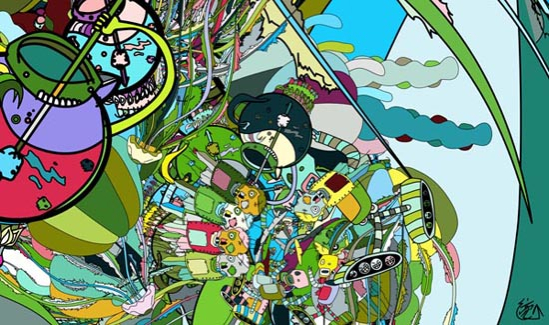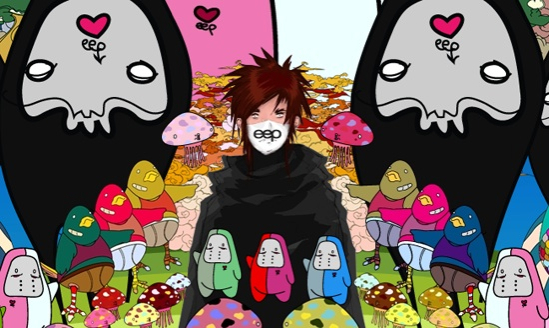Speartalks: eepmon

If we can trust what Wikipedia has to say on the matter, people born in the Chinese Year of the Monkey have it made. They are smart, quick witted, inventive problem-solvers, and they come with a side of sharp-shooting, horribly unfair skills– like the ability to absorb conversations happening around them, even while they themselves are heavily engaged in another.
Eric Chan, also known as eepmon, is a young, Ontario-based new media artist with enough experience under his belt to make much more seasoned designers quiver. He is also an enthusiastic member of that lucky Zodiac sign– and from what we can tell, should be, as he fills in its outlines to an intimidating degree.
Read up as we talk with Eric about his bright future, his studious (and very recent) past, and the exciting things that have been bridging his path from day to day.
Joshspear.com: You chose the name eepmon because of a few ways you relate to your birth year, the Chinese Year of the Monkey. Can you tell us a little bit more about what your name means?
Eepmon: Sure. eepmon is an amalgamation of several things. A play of words really"¦ I used "e" simply because my name starts with the letter "e," and "m-o-n" are the first three letters for "monkey." eepmon is also a twisted form form of "ape man."
As to why I chose it to relate to my birth year of the Monkey, it is because I appreciate the philosophy behind it. Just wikipedia it if you want to know more about it. They are curious creatures, always moving around, playing, enjoying life, work diligently and most importantly "“ being who they are.
I wasn't looking to have a name that has a rock star sound to it nor does it have to have any sort of corporate theme. I want the world of eeps to be me, and just me.
I decided that if I was going to have a career, then that was the type of path I wanted to follow – and I think the only way to do this is going at it freelance-style. Work hard and enjoy life on your terms.

JS: You can be described as an incredibly successful designer, yet at almost all points of your career thus far, you've been pursuing even more of an education. Why so much schooling?
E: Hey, thanks. I guess that is part of my curious nature.
Whether you are in school or not, learning is especially fundamental in the creative industry. We are encouraged to learn otherwise we will expire.
I knew early on that my passion revolved around the visual-arts / computer technology, and thus wanted to invest my time into it. I think that a good method for me at that time was going to school. Mind you – as I'm sure many will agree with me – there is a lot of crap you learn in school that you end up not using; however, I believe in the grand scheme of things, whether they will directly or indirectly be a value added to your foundation.

JS: There are definitely advantages to being both a designer and a programmer. What have you found that doing both – and doing both well – has allowed you to do?
E: Well I can't really say concretely as I think it is something that is instilled in me. But what I have come to notice as I work is the ability to see the big picture, or as I had put it in another interview, "the forest through the trees."
The Flash and processing projects that I do on the side could be examples. When I work on sketching out GUIs, etc., in the back of my head I'm thinking, "Ok. What would be the best method to develop this? How can this GUI be broken up into subcomponents and written into neat packages? How can I write these packages in such a way that they are generic enough to be reused across the application? Do I even need to go that far? Maybe one class is good enough? Am I stupid? Do I feel like playing Street Fighter 4?" OK, I'm getting off topic here, sorry.
More importantly, I also think that this duality of thinking goes beyond my career and into my everyday life. I don't know how but I'm sure it does.

JS: Your work always feels like it’s growing to me; like each piece started with one element or object and just sort of took off from there. Is it safe to guess that you build off of one element when you begin working?
E: Depends. I think this growth you refer to usually starts with the theme in mind. With the theme, I begin brainstorming wildly and draw things that I feel relating to it. Sometimes I just want to go all out without restrictions.
JS: You were recently working on an interactive installation piece, which has always seemed like a very scary artistic endeavor to me. Can you tell us about it, your process creating it, and how it all turned out?
E: This interactive installation was our final senior project under the team name of EmoCapsule. My comrades were Hannah Johnston, Alicia Landry and Jordan Shaw.
Yes, we all felt it was a challenge, but that was what motivated all of us. In fact, I am extremely pleased to say that our hard work paid off. We just found out that (literally the day right after you sent me these questions) our project has been accepted into the Space Time Interactive Competition, which will be shown at the 2008 ACM SIGGRAPH Conference in LA!
I was the lead programmer of the application. What we envisioned was an installation that constantly changes "moods" based on the "feeling" of the Internet. People were asked to go to our super alpha site to answer a simple question, "How are you feeling?" The user submits their emotion, which on the server-side compiles the statistics, and by leveraging the Google API we were able to figure out with some degree where these emotions were being submitted. So yeah, we can finally prove that, overall Vancouver, Canada is feeling pretty down. (JOKING!).
With the data provided, people who are in the installation can interact with the "mood" words that float around in scene. We have done research to correlate emotions with color and used specific sound effects as well. So, if the overall mood is "worry," you will hear sounds that we feel reflect worrisome.

JS: You do design work for clients in both the US and in Asia. Your style is obviously consistent across borders, but in general, would you say that there are any significant differences between current American and Japanese design?
E: I believe that our boundaries are becoming increasingly blurred with the advent of the rise of the Internet. Design is a very malleable medium; if you laid out recent design works of an American designer and a Japanese designer side-by-side, it would literally be impossible to distinguish. We have American designers adopting "kawaii" from Japan just as Japan adopting styles from America.
Is this a good thing? I think so. It is a sign of our time's progression forward by exploring and sharing newfound creative expression.
JS: When some people work creatively, they function best in a very specific environment. Where are you happiest working?
E: Yeah, I do. My creative thinking doesn't kick in until 11 p.m., and it lasts until the birds start chirpin' – like 5:30 a.m. It's insane, but I think psychologically I am much more focused because I know most people in my area are sleeping, and I can comfortably know that no one will disturb me. I've got music playing in the background, room surrounded in darkness except for my display"¦ and of course my peeps from Asia are wide awake, so I guess I can't be totally alone!
JS: If you could change anything about the art and design world today, what would it be?
E: Hmm; a good question. I would like to see the day where art work created digitally could coincide more with artworks in major galleries.
Digital artwork is an undeniable medium, and it deserves a place in the world of fine arts. However, currently it's just like when traditionalists denied photography as a true art form – I can't help but feel there is still that sort of stigma towards the digital medium today.
JS: Tell us about the Mini collab!
E: For sure! Chris Zawada from Taxi Design saw a great opportunity in my works and contacted me to see if I was interested in doing a collabo with Mini. Without hesitation I agreed to work on a full 13 illustration – 13 month Mini 2008 calendar. The calendars have already been distributed across all Mini Financial Services in Canada.
All I can say was that it was a great experience in everyway. Most importantly, it was challenging. It was a tight deadline, and on top of that I was still in school, so there were many late nighters of course – but yeah, that’s what I call hustling!
In the end the eepmon x Mini collabo was a success, and nothing can be more satisfying than that.
JS: Computer Arts Graduate Showcase of 2008 – congratulations! Can you tell us exactly what that means and when we can find that issue?
E: Thanks! I am honored to be among the peeps in the 2008 Graduate Showcase. Every year, Computer Arts Magazine (a UK based magazine) holds the Graduate Showcase competition where all final year graduate students in design and art institutions compete to be in a book. The book highlights the year's best graduate work, and this year was even more competitive as they've opened up the competition to an international platform. I think being included in this book is a great way to conclude my curriculum.
It will be in issue 150 (June 5th, 2008), so by the time this interview is published it will already out and can be picked up at a local Indigo, Chapters or some place similar.

